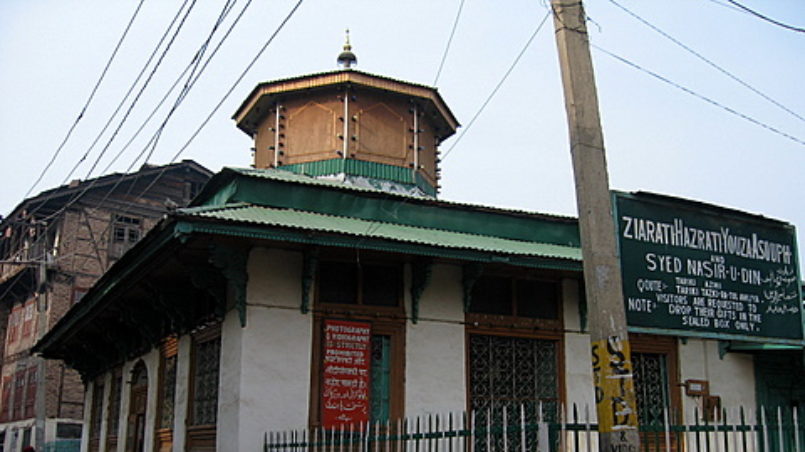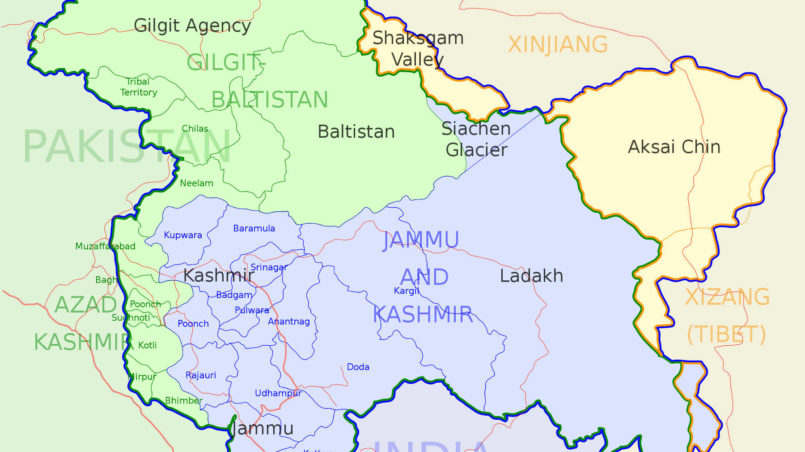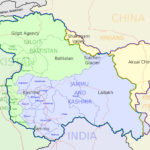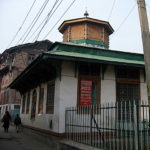Roza Bal Shrine in Kashmir: Tomb of Jesus or a Myth?

The state Jammu & Kashmir (J&K), or also known as “Heaven on Earth” or the “Switzerland of India”, is located in the far north of India, bordering with the Line of Control (the military control line between India and Pakistani controlled parts of the state Jammu and Kashmir) to the west and north and China to the north and east.
Nowadays the greater part of Kashmir is under the control of India and Pakistan and a small part under China, but the state has a special autonomous status. Soon after the division into independent countries of India and Pakistan, in 1947, the political conflicts in Kashmir began and have continued until today.
J&K is split into three districts: Ladakh, Jammu and the Kashmir Valley. Ladakh (“Little Tibet”) being a prevalent Buddhist area and Jammu and the Kashmir Valley being a prevalent Muslim area. J&K is also the only state in India with a dominant Muslim population (according to the 2014 census, Islam is practised by approx. 97.16% of the population).

I went to Ladakh last year in September and I absolutely fell in love with this region, the nature, the people, the atmosphere – everything was just stunning (to read about my journey there, please click here).
This year, in February, the situation in Kashmir became more stable and as soon as we found this out, we booked a flight to Srinagar. This was our chance! Besides seeing the natural beauty of this region, there was one thing in particular which attracted me to Kashmir: the Roza Bal shrine (Roza is a Persian word and means holy, Bal is Kashmiri and means shrine).
Locals living near to the shrine (Sunni Muslims, the largest group of Islam), however, strongly believe that Yus Asaf was a Muslim holy man and not Jesus Christ.
This is a very controversial subject and it all started in the late 19th century when Mirza Ghulam Ahmad, the founder of the Ahmadiyya sect of Islam, published the Urdu book “Christ in India”, after doing in-depth research on this specific shrine. Since then Ahmadiyya followers believe that Jesus did not die by crucifixion (they believe that Jesus was placed on the cross only for a few hours, but that death by crucifixion would usually take days), but that he survived and travelled all the way to India over the former Silk route, connecting Europe to Asia, in order to escape persecution.
His mother, Mary, accompanied him but she died along the way and her tomb is to be found in a town called Murree, which was named in honour of her and is now a part of Pakistan. The place where she is buried is known as Mai Mari da Asthan, which means “resting place of mother Mary”.
An interesting fact is that about 50 km from Srinagar, in the village of Gultibagh, such a lost Jewish tribe is to be found.
Could this really be true? I would love to visit this village and see for myself and I really hope that the political situation is stable enough one day so that I can travel to this village.
Let’s see …
From my further research into the subject, I found out that Jesus apparently didn’t come to India for the first time after his crucifixion, but he had been there before, during his “unknown” years: from the age of 13 to 28. Information regarding the theory of Jesus’ journey to India started to appear with Nicholas Notovich, a Russian traveller, who visited Kashmir in 1887 and afterwards in 1894 published the book “The unknown life of Jesus Christ”.
During his time in Kashmir, Notovich visited the Hemis Monastery in Ladakh and since he had to stay there for about one and a half months due to a broken leg, he interacted a lot with the monks and consequently the chief Lama (Buddhist monk) showed him some very old handwritten manuscripts – entitled “Life of Saint Issa” (Issa being the Tibetan name of Jesus, and Hazrat Isa or Isa being the name for Jesus stated in the Qur’an). The texts were a Tibetan translation of the original Pali texts, which are believed to still be in the monastery of Marbour near Lhasa, Tibet, and they reveal the “lost years of Jesus Christ”: from the age of 13 to 28. Even in the Holy Bible there is no story about Jesus during these years.
He entered Punjab and then Rajasthan, north India where he spent some time with the Jainism (ancient Indian religion, founded on three principles: non-violence, non-possessiveness and non-absolutism), continued further towards the east, Orissa, where he studied the deep knowledge of the Vedas (the Vedas are the most ancient Hindu scriptures, divided into four books covering a large body of knowledge), until reaching the Magadha empire (at that time, the kingdom where Buddha was born and grew up). There Jesus attended some esoteric schools and became familiar with the teachings of Lord Buddha. He then proceeded towards the holy city of Varanasi where he stayed for a few years.
According to the Hemis scriptures, Jesus proceeded to Nepal, Tibet and Ladakh and then returned home. During his travels, he was influenced by the Veda teachings from the ancient Hindu scriptures, learnt brotherhood, peace and other principles from Buddhists and consequently taught the same principles – the “Eight-Fold Path” – such as right understanding, right speech, right action and peace to his scholars when he returned home at the age of 29.
He was severely discredited in Europe but in India some appreciation was shown to him by Swami Abhedananda (a religious teacher), who then visited the Hemis monastery in 1922 to confirm the reports of Notovich. Upon his arrival, the monks indeed confirmed Mr. Notovich’s presence at the monastery and showed and translated some more text from the ancient manuscript “Life of Saint Issa” to the Swami.
What do you think? Does the Holy Bible know nothing about Jesus from the age of 13 to 28 because he was really in the east to study with the Buddhists? Is it really possible that the whole truth is written in those ancient manuscripts kept in Tibet? How many months must he have travelled, considering that the distance from Bethlehem to India is a minimum of 3,845 kilometers? What difficulties must he have faced? Since at that time there were kingdoms everywhere, do you think it would have been “easy” to pass through various kingdoms, considering that nowadays in many places it is very difficult to go from one country to another…?
Over the years the Roza Bal shrine has received an increasing amount of attention and many studies have focused on the shrine, with very interesting discoveries: the tomb is directed towards east-west which is distinctly a Jewish direction and not towards the north and south as would be the case with Muslim tombs; in the shrine there are some footprints carved on a rock, resembling feet which show deep wound marks, like those from a crucifixion. If Yus Asaf really was a Muslim prophet, why didn’t they build the tomb facing north-south? And isn’t it quite mysterious that the feet carved in the rock show wounds which would be inflicted in the course of a crucifixion, exactly like those Jesus had?
Dr. Fida Hassnain, an expert Kashmir archaeologist, writer and professor has visited the shrine several times and he states that he also found a rosary in the grave. He and Suzanne Olsson, an American author who wrote the book “Jesus in Kashmir and The Lost Tomb”, have spent an immense amount of time studying the shrine and say that Roza Bal should be taken over by UNESCO or the Government of India to preserve it, as it is a national heritage site, which should be open to the public. They have been trying to perform a DNA test in the tomb but that mission remains unsuccessful until today.
Many historical texts in Sanskrit, Buddhist, Arabic and Persian show that Yus Asaf is another name for Jesus Christ. In fact the name Yus Asaf has been mentioned in two great ancient Urdu books stating that Yuz means “Leader” and Asaf means “purified or healed”, referring to the “Leader of the Healed”, as Jesus Christ healed many people suffering from leprosy along his way. Another term for Yus Asaf in various books is “Son of Joseph”.
What do you think? Is it really the tomb of Jesus or just a myth? Did Jesus travel to India in his “lost years”? And if this were true, what impact would this have on the Catholic Church?
(If you would like to know more about this subject you can watch the movie, Jesus in Kashmir (by the Government of India))
In the days before flying to Srinagar, I read a lot about the political situation and check the news almost daily to see how the situation is there at the moment, since obviously I am having one or the other doubt about travelling there. Just one day before my flight, I check the news again and I must admit that I don’t have a good feeling at all. I somehow feel as if I am going into a war zone but I convince myself that the conflicts are between the military and the rebels and that nothing has ever happened to a tourist.
We fly on a Friday from Delhi, and Friday is also usually the day when there are conflicts between the protesters and the soldiers, but luckily on this Friday, it was announced in the news that the there will be no protests.
See you soon Kashmir …
Credits
| Image | Title | Author | License |
|---|---|---|---|
 |
Kashmir_map | Planemad | CC BY-SA 3.0 |
 |
Rozabal | Cacahuate | CC BY-SA 3.0 |
